On Tuesday I showed you my recently thrifted tops for fall. One of those pieces is a “tribal” top from Xhilaration, meaning it features a print drawing from the art of some sort of tribal culture, often indigenous to the Americas or Africa. (This phenomenon also happens with Indian, Polynesian, and Asian cultures, although I haven’t seen those labeled “tribal”—I’m thinking henna as decoration, fish hook necklaces and puka shells, Chinese character tattoos…unfortunately the list is pretty long.)
In the case of my shirt, we’re talking about a riff on a Navajo pattern:
Similar patterns are easy to find on the Internet:
Laramie Blake wears a biil, a traditional woven dress. Source
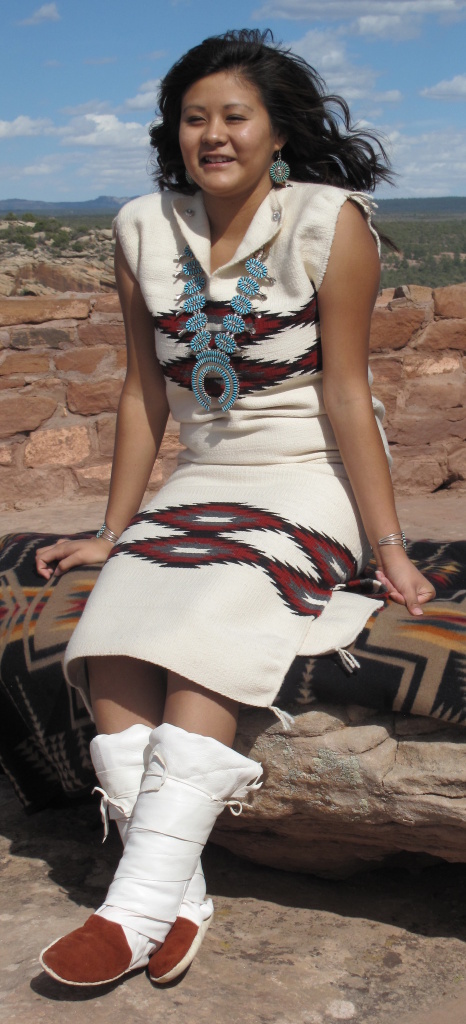
Anita Bekay with her prize-winning rug from 2012. Source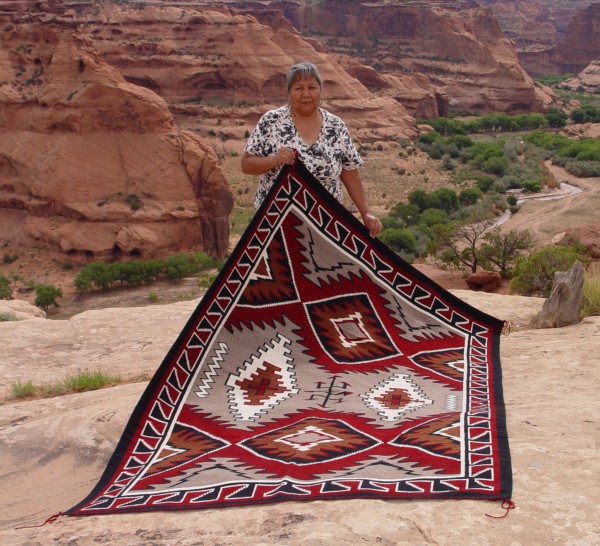
Alice Roy in front of a rug she wove. Source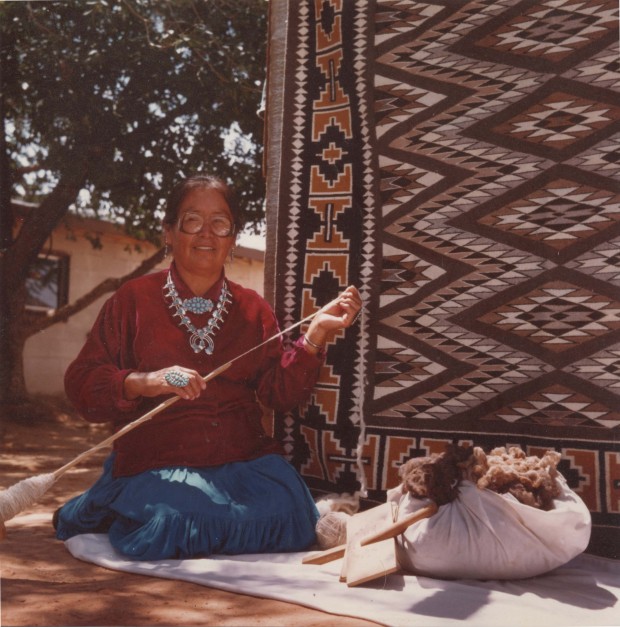
You can google “Navajo weaving” and see a bunch more of these style that look even closer to my shirt, but I chose pictures with the women who create and wear this pattern to make a point: patterns like this mean something in their original context; they weren’t created in a vacuum but instead are tied to the lives, beliefs, and values of real people—real people who are at best obscured by such representations and at worst oppressed by the culture that appropriates them.
What’s cultural appropriation, you say? So glad you asked!
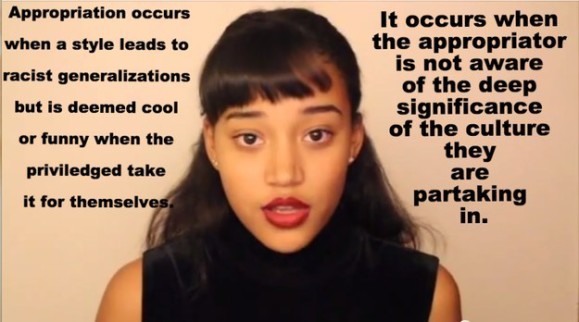
Thanks Amandla!
I am growing in my understanding of cultural appropriation by White people of Black culture, and thanks to a badass high school history teacher, I’ve been aware for even longer of the crippling, centuries-long oppression facing Native peoples in the US and how their images and artifacts have been used to turn a profit without their permission. (Thanks Ms. Davis!)
In other words, there’s a reason you’ll never see me do the “Tomahawk Chop” even though I live in Atlanta.
But, to be honest, I had never realized how very directly connected the fun, funky “tribal” patterns at Target (or in my case at the thrift store) are to the appropriation of Native cultures. In fact, I was waiting for just the right “tribal” print to make it through to the thrift racks so that I could make it my own. Ahem.
Thank God for the Internet, because a guest column on a style blog I read highlighted some particularly egregious examples of high fashion cultural appropriation, and a light bulb went off:
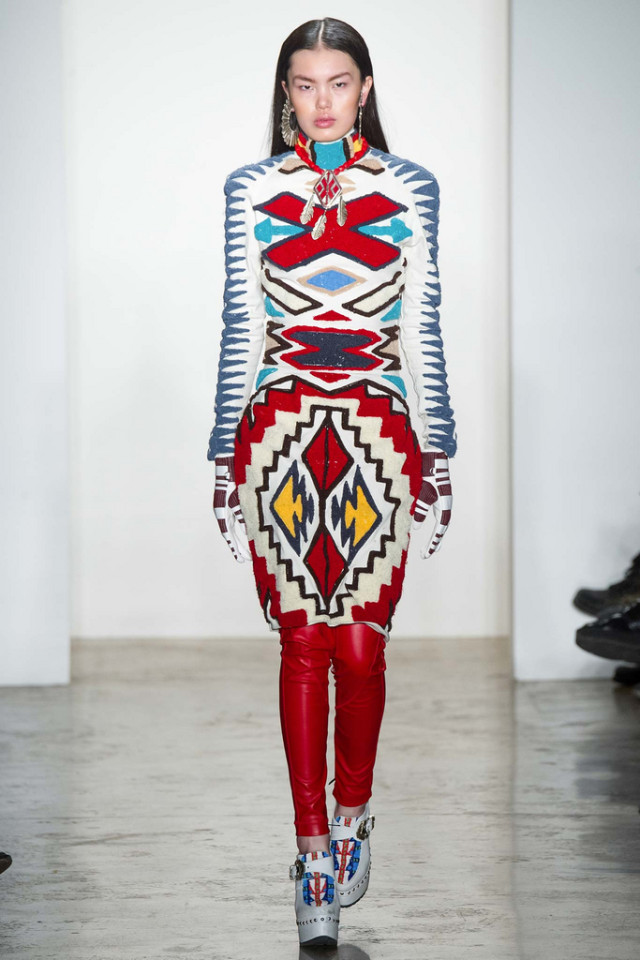
From KTZ. Source
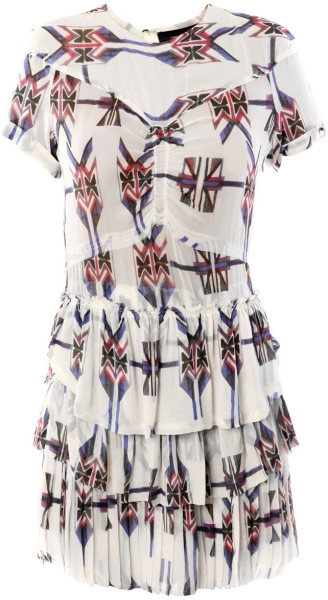
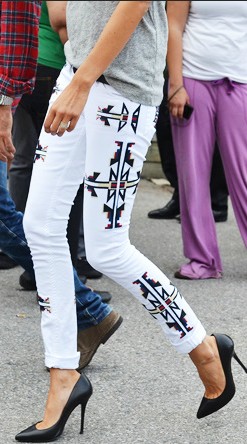
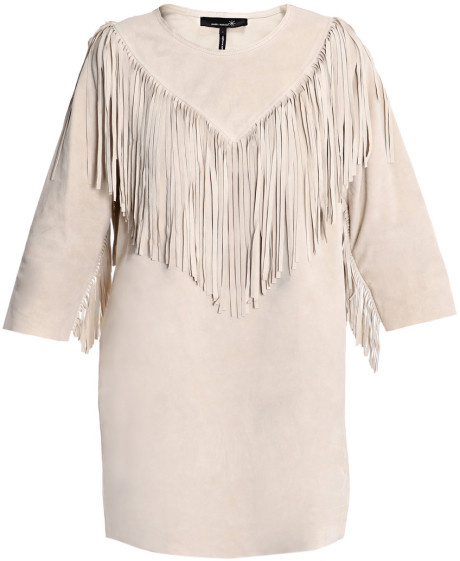
From Isabel Marant. Source. Source. Source.
Hits a little too close to home in the “let’s dress up as Indians!” department.
That first post led me to Native Appropriations, where Dr. Adrienne Keene wrote about the appropriation of Native imagery by non-Native couture fashion, including an instance where a designer blatantly copied from a dress by Northern Cheyenne/Crow artist Bethany Yellowtail with no credit attributed and with no understanding of the spiritual or social significance of the images used without permission:
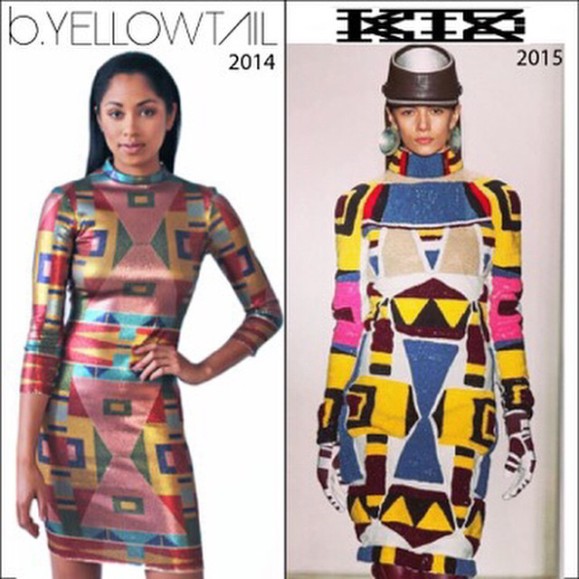
Different color scheme; same shapes, cut, and general pattern.
Maybe you don’t see a direct enough resemblance here to merit outrage; after all, there is “nothing new” under the sun and all fashion is basically a riff on what’s come before, right? Just like pop drawing on hip hop, right?
It’s true that art forms of all kinds are always borrowing from, drawing off of, others’ creativity. But to me it comes down to a power difference.
When those of us who have more power in this society make something our own that has its origins in the creativity of a group with less power, that group is never in a position to control how their art, fashion, music, etc. is used.
It becomes a monologue instead of a conversation, and a monologue borrowed without permission at that (one might say stolen or cribbed or plagiarized), a piece performed as one’s own without recognition of, or respect for, the place it came from. (See: Iggy Azalea.)
As Dr. Keene suggested, non-Native designers can work with Native designers to produce original content for their fashion lines, highlighting that collaboration and the origins of the imagery they use. But few, if any, ever do.
I can choose to support designers like Bethany Yellowtail (and others mentioned below) and continue to do my homework on issues facing Native peoples and the brutal history of violence and betrayal perpetrated by my country that led to those issues. A B. Yellowtail dress doesn’t come with an asterisk explaining my outfit’s provenance to the average passerby, though. All they see is a fun, funky “tribal” print making me look hip and chic; no one learns that Native designers are doing amazing things (unless they compliment me on my awesome outfit and I get the chance to tell them). No one is challenged to acknowledge that the rip-off mass fashion patterns that look so similar to what I’m wearing came from somewhere, a “somewhere” that is rarely celebrated or even represented in the dominant culture in a positive way.
And that’s not so chic.
I’ll be skipping the fast fashion “tribal” prints from here on out, and I’d love your thoughts on wearing the work of indigenous/non-White designers who draw inspiration from their cultural traditions – particularly if you identify as belonging to one of those cultures.
—
Resources:
More of Bethany Yellowtail’s goregous work
Beyond Buckskin: supporting Native designers through resources, artist profiles, a shop, and a roundup of Native-designed brands—thanks Stephanie!
8th Generation, the first Native company to make wool blankets—they’re incredible, check them out!
Just a taste of the oppression of indigenous peoples in the US
Ankara (West African wax-resist fabric)
Kenji Yoshino’s similar argument re: wearing ivory
Interesting article on Pendleton’s collaboration with Native communities–when does it veer into cultural appropriation?
(Please leave more resources in the comments!)
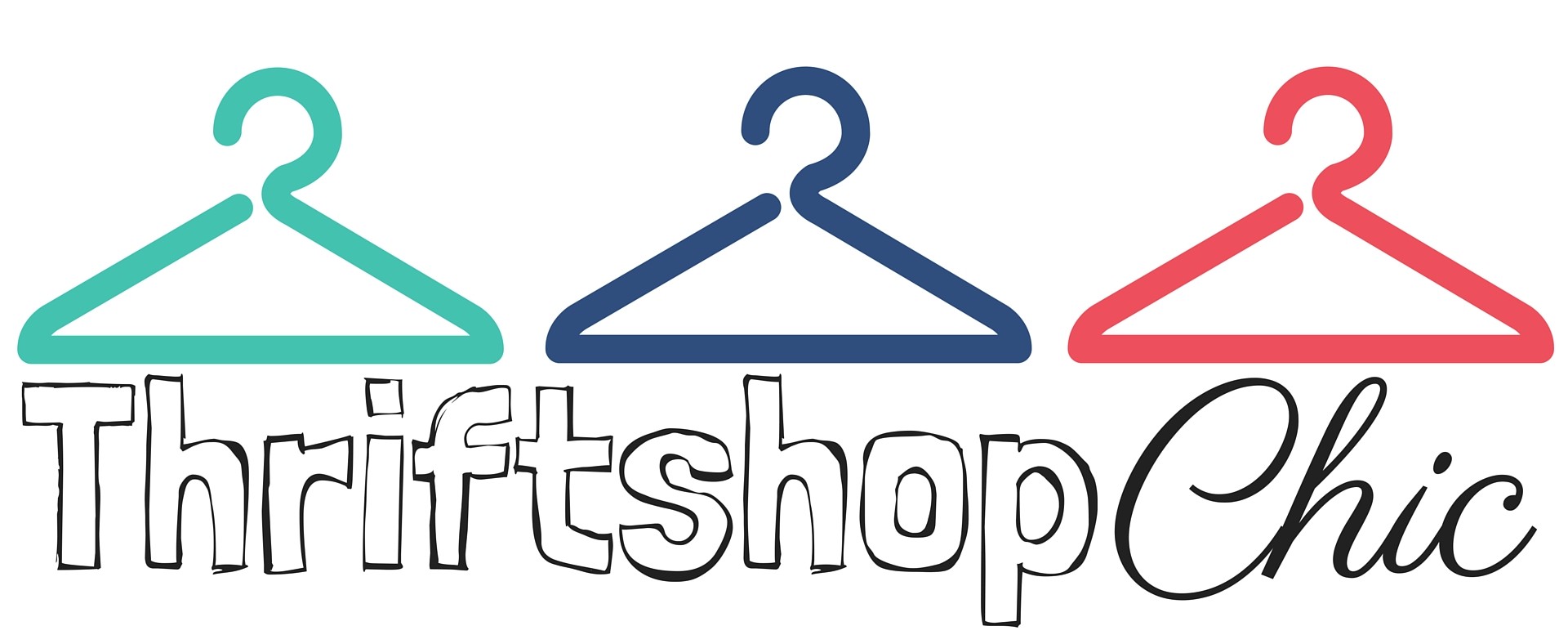
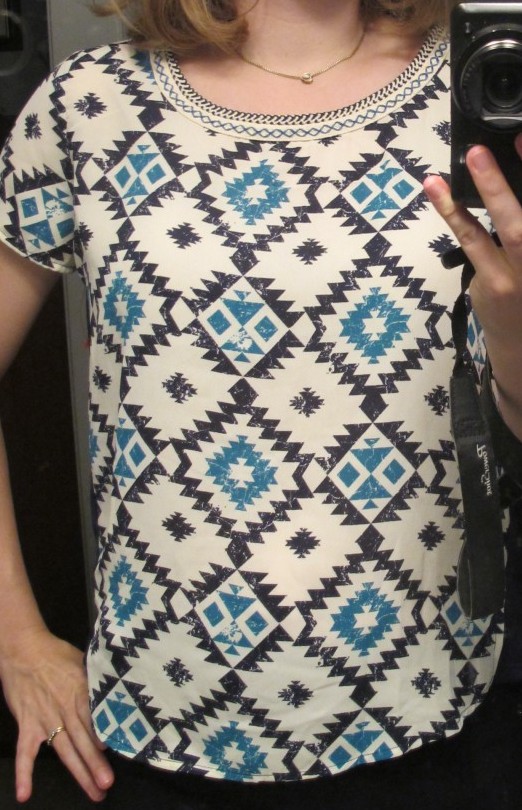

Hi Leah, this is an interesting and important discussion. I don’t think there is any one, clear-cut answer. I don’t think that all indigenous people would necessarily want you to not wear anything drawn from their cultural heritage. In many ways, wearing something from another culture really is paying tribute to its aesthetic and symbolic elegance. And sometimes people from that culture see it that way, as this interesting post by a second-generation Indian-American woman points out: http://www.xojane.com/issues/my-indian-parents-are-fans-of-cultural-appropriation
I also think that insisting on preserving indigenous fashion as only appropriately worn by indigenous people can be a way of indirectly asserting a notion of cultural fragility or patronizing them in their “purity,” when in fact these cultures often participate in the global cultural exchange of ideas, fashions, customs, food, etc., with just as much complexity, resilience, influence and influenceability as other culture groups, like Italians or British or Japanese or what have you.
Yet I also understand that the situation is quite different when a minority culture is oppressed by the dominant culture where they dwell, and on their own bodies their fashions are cause for discrimination and stereotyping whereas on other bodies their fashions are cool or beautiful. Not to mention the issue of misappropriation and profanization of symbols and designs that have deep significance in their original context but are just to “look cool” on white and other privileged bodies. You mention all this, but I’m just reaffirming that I agree, it should give us pause before wearing fashiong inspired by any minority/oppressed culture group.
So like I said I don’t think there is any one clear-cut answer, but I would hope for those who do choose to wear a Navajo pattern shirt or something of the sort, it could be a conversation starter they would use to verbalize the missing “asterisk.” And even more importantly, they could listen to the thoughts of anyone who does identify with that culture and that could shape their decisions about if, when and how to wear such clothes.
Thanks for your thoughtful comment, Sari!
I love your point re: fragilizing/patronizing indigenous cultures by implying their designs can never be worn by non-Native peoples as they’re somehow not strong/mature enough to participate in the global exchange of ideas, designs, etc. (this is of course different from objects/clothing designed specifically for religious purposes or given as gifts with heavy symbolic meaning, i.e. eagle feathers).
So I think there’s a case to be made for non-Native people wearing Native patterns, designs, etc.—but in the way that Adrienne Keene talks about it, i.e. items that have been designed by or in collaboration with Native designers and artists. That way you’re supporting Indigenous artists. …but again, how is the average passerby going to know you’re any different from the hipster wearing Urban Outfitter’s latest Pendleton marketing scheme?? Ah, it’s definitely complex! (btw just added article on Pendleton to resources at end of post)
Can’t wait to read the xojane article, thanks for sharing!
What bothers me about this objection to cultural appropriation is that some of what is called cultural appropriation is actually just straight up copyright infringement stealing from a particular person influenced by their own culture.
Hey threeyearslater,
You’re right – in the case of Bethany Yellowtail it’s definitely copyright infringement territory, although I imagine the cultural piece of it might add to the sting. Of course we could decide to only patronize people of a particular culture creating fashion inspired by their own tradition, thus getting around the copyright issue – but how does the average passerby know the difference?
In other cases you can’t link the particular print used to a specific artisan, but it still reads pretty tone deaf to borrow someone else’s culturally and/or religiously significant motifs just to look cool.
Thanks for your comment!
I’m a big fan of aztec prints, and maya culture.
Really love the patterns, and wear them.
I’m white and don’t like white culture, I don’t even identify with being white, really!
Even if I would be marginalized because people see this as cultural appropriation, I’m not gonna bother because it sucks a lot of energy. I have a lot of respect for the maya culture. I love it, it makes me feel at home. These are the patterns I see when doing San Pedro or psychedelic shrooms. I feel connected with the pattern, so i will wear it, even if I get rejected by some. Peace!
Hey Rogear – to each their own!
What you’ve written is a great example, though, of what’s problematic about the mindset of groups of people in power – aka those of us with privilege. Not listening to what current Nahua (Aztec) and Mayan peoples (they’re different, by the way) have to say about how they feel when people mass produce their heritage and make a profit off of it with nothing returning to the people themselves because it takes too much energy is actually hugely disrespectful. And it’s great to feel at home in another culture – but at some point you have to recognize that it’s not yours, and that you have the freedom to not identify as Nahua and/or Mayan and reap the benefits of being seen as white in the world whenever you want. An indigenous person from Latin America has no such luxury and doesn’t always have the resources to fight effectively against the appropriation of their culture.
You haven’t written much about what you respect in Nahua or Mayan cultures apart from patterns and doing psychedelics – I’d really encourage you to learn about the history of decimation and oppression of both these peoples and their surviving Nahua and Mayan cultures and see if you can find a way to contribute positively to their thriving, maybe by buying directly from indigenous artisans or by giving to non-profits run by indigenous peoples and dedicated to continuing their cultures.
Peace to you, too!
Hi, it’s ok to have your opinions ready to trow. But I dont like to walk around in Gaastra jackets or whatever, because it’s not me haha. I reject that kind of thinking because it’s oppressive. In the Netherlands, I’m raised with different people around me. I like different types of music, and if I make a hip hop beat, I do it because it comes from within. I’m a youth empowerment worker, and sometimes these subjects make me concerned. Well, nobodies perfect, but I don’t make a big deal out of it. The patterns on my Indonesian cap, or the 80’s blouse from a retro store. I want to be inspired by it, I want to share. I like briges not walls. I like different cultures and see the intercultural change as something positive. I try to have my own style. And try to do it with respect. Have a nice day
And, if I see something thats made fair trade and eco-friendly its even more perfect. Just will check these things as well. Hope to support it in a way those people can take their own power and heritage. Always nice to learn new things
I’m a bridges-not-walls person, too – and I think being aware of the history and power dynamics involved helps make those bridges more effective and less likely to turn off the people and cultures with which we want to connect. Like Indonesia’s history of being colonized by the Dutch – that would make for an illuminating conversation with people of Indonesian descent in the Netherlands. Some might not care at all, and some might like a chance for people to learn more about the significance of their cultural symbols. When I’ve worn a sari to Indian-American friends’ weddings, I’ve had both positive and “who is this white girl?” reactions. Could be interesting to explore!
Cheers :)
I’ll be a guilty white and privileged Dutch guy, there is no escape how much I try ;)
Or a thoughtful, engaged one :) I fight that tendency all the time here in the US, too, but it feels so much better when I’m listening to and learning from the voices of people with not so much privilege and doing some of the things they say are helpful to be in solidarity with their struggles. Good luck, don’t give up!
Hi!
I think part of the answer is to buy from the source.
That way you are supporting the culture and in return you get a super authentic version of print you love!
Good point! And it’s becoming more and more possible and accessible to buy directly from the source, and I find the quality is a lot higher and it’s more likely to be clear that it’s “authentic” vs.
a knock-off.
Hi Leah, I found your article helpful and have been pondering something myself that I would appreciate your insight.
I recently thrifted a handful if tees I believe are originally from the Institute of American Indian Art in Santa Fe. They are beautiful deadstock vintage, some designed by the artist Pat Ryan (Wounded Knee memorial series, I believe). The art is mostly portraiture of Native American men dressed in traditional Lakota attire. Another tee just has a portrait of a Navajo man in headdress and says UTAH. So the tees are not borrowing any tribal elements in the style, they are just tee shirts. But wearing art depicting Native Americans, is that potentially inappropriate for me as a Caucasian woman?
I also considered reselling some of them, but I question that a little as well. As a parallel example, I recently bought 2 kimono style robes from an estate sale. One is clearly just a robe and doesn’t borrow any major style or pattern, but the other looks quite traditional. I personally would wear the first one, but not the second. The 2nd kimono, I want to somehow find an appropriate buyer who respects the delicacies of cultural appropriation (TBD!)
So as much as I love these incredible tees, I just want to be thoughtful and learn what I can before moving forward. If I’m honest, I can’t see how this could be problematic exactly, but ready to explore if I’ve got a blind spot here.
Thank you for your time!
With maturity, comes the wisdom to “pick your battles.” One can not live with ANY level of peace when that person is CONSTANTLY concerned with what others think. Tolerance extends beyond oneself. We all have a duty to be more tolerant. If I like an Aztec sweater, I will wear it. If it offends someone, then that is their problem and not even mine. I can think of many causes that one could support that are less self-congratulatory and more productive.
if the customary/sacred hat worn in my community was being worn by people outside the community, with 0 knowledge of what it signifies – I wouldn’t feel offended (that’s just me) but it would tell me that, that person is kinda ignorant, that’s all
Trust me, the majority of people, and that majority is very large, do not mind if you wear modern clothing with tribal prints. Some may be offended, but that’s ok. So just be kind, help others when you can, and enjoy the short life we all have in your underwear if you’d like.
And what of the Native Americans selling Aztec and Mayan art as their own? Is that not considered cultural appropriation? Indigenous people live across the globe, Hawaii, Africa, India, Australia, Canada, USA and Mexico amongst others….. I’m rather confused as to why I find many Aztec patterns and art being sold in Canada by Natives of this land as their own designs. Also after much research I have come to learn that many cultures have been burning sage for spiritual, cleansing and ritualistic reasons for centuries such as Egyptians, Ancient Roman’s, Ancient Greeks and even witches . I’m not arguing that the plant hasn’t become widely and overly used, it must be harvested in a sustainable manner, however when did it become cultural appropriation? I was just online watching a video of a Native American man furious that people from India are selling beaded items for cheap, calling it cultural appropriation but again beading is and has been a way of art for the people of India for centuries as well as Africa, Asia, Afghanistan, Tibet and so on. Is this “Cultural Appropriation” movement going too far? Shall we not research and respect all cultures and their traditions or are all art forms practiced by the Indigenous people of Canada and the USA completely of limits to all other cultures now? I’m puzzled and genuinely curious to hear the responses because something doesn’t feel right to me about this topic and the way it’s being represented here in Canada. I admire the blood sweat and tears that Natives put into their beautiful art but i also admire that of other cultures as well and there are many many others! Before you tear me apart please understand that I am not a racist, I do not burn sage, bead or sell art of other cultures, I am just a person learning and growing in this “new world.”